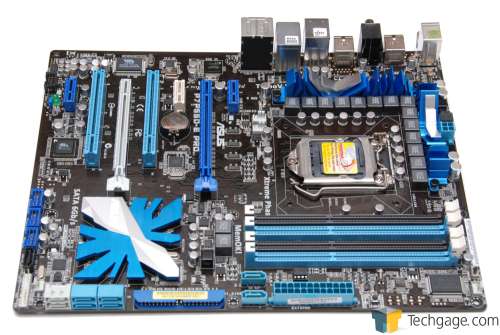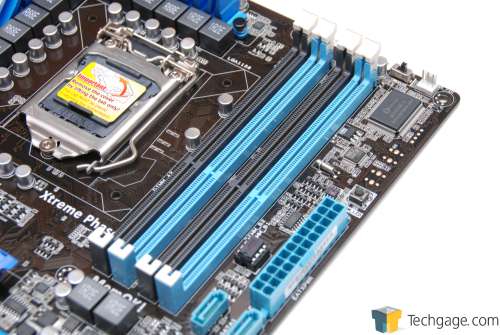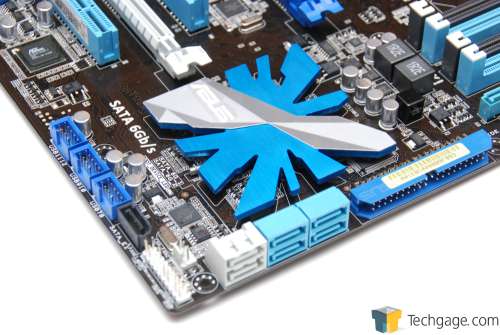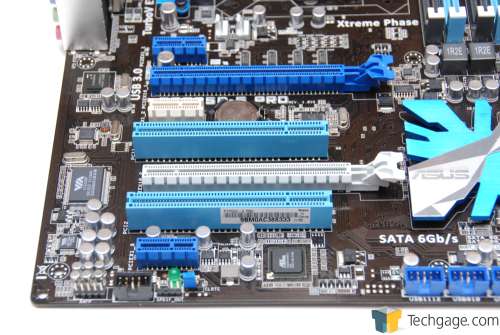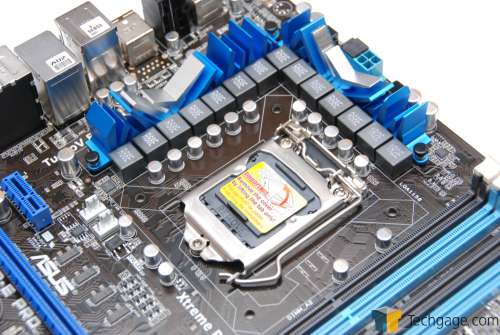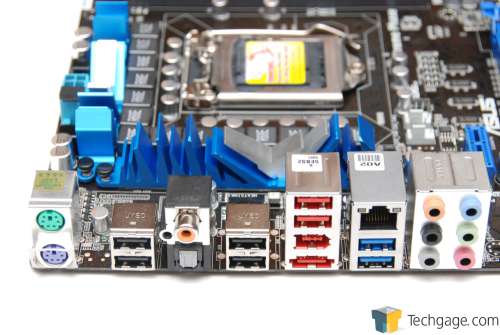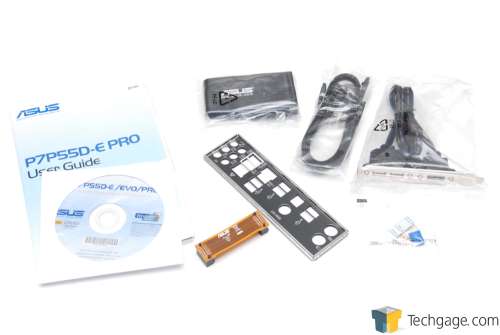- Qualcomm Launches Snapdragon 4 Gen 2 Mobile Platform
- AMD Launches Ryzen PRO 7000 Series Mobile & Desktop Platform
- Intel Launches Sleek Single-Slot Arc Pro A60 Workstation Graphics Card
- NVIDIA Announces Latest Ada Lovelace Additions: GeForce RTX 4060 Ti & RTX 4060
- Maxon Redshift With AMD Radeon GPU Rendering Support Now Available
ASUS P7P55D-E PRO
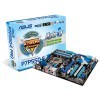
A couple of weeks ago, ASUS released its first two under-$200 P55 motherboards that support both S-ATA and USB 3.0. We’re taking a look at the higher-end of the two, the P7P55D-E PRO. As you’d expect, this is one packed board, featuring a great design and a number of improvements over the company’s P55 launch boards.
Page 1 – Introduction
Last month, we published our look at one of ASUS’ popular P55 launch motherboards, the P7P55D PRO. Judging by model name alone, the board we’re taking a look at here doesn’t seem too different. In fact, the only difference from that perspective is the -E that’s been added. So what is the difference? The most notable is the addition of S-ATA 3.0 and USB 3.0 support, along with other additions that makes this more than just a revision.
Price-wise, the P7P55D-E PRO retails for ~$20 more than the original, and whether or not that’s worth it will be up to your specific tastes. The addition of S-ATA and USB 3.0 could be considered worthy of the higher SRP alone, especially since ASUS implements a PLX solution, meaning that neither S-ATA or USB 3.0 will draw bandwidth from your primary PCI-E 16x slot, which is what happens on current Gigabyte P55 boards that feature these two new technologies.
The other major (or minor, depending on how you look at it) change is in the form of additional options in the BIOS, and added options, such as improved CPU Level Up options, better fan controls and so forth. But while this board is quite similar to the non-E version, I’m going to be taking a fresh look at it, because with the first board, I tested it two months before I wrote the review, so for the most part, this feels almost like a completely new board.
Closer Look at ASUS’ P7P55D-E PRO
I don’t include pictures of product boxes all too often, but once in a while one will stand out, so I feel compelled to include it. If you’re familiar with ASUS’ recent motherboards, then the box below is going to be quite a bit different than what you’re used to. Most boards I’ve received in recent memory, aside from the Republic of Gamers’ models, have been shipped in blue or green (depending on AMD or Intel) glossy boxes.
Personally, ASUS’ boxes have never really impressed me much, but in all seriousness, it doesn’t matter. It’s a box, and as long as it protects what’s inside, that’s what matters. But here, it looks as though ASUS has decided to refresh its thinking, and “fresh” would be a good way to describe the packaging for this board. It’s bright with many colors, and still sticks to the blue theme. When taking it out of that brown corrugated cardboard shipping box, it feels like you just opened up a box of sunshine. It’s strange, sure, but I think it’s true that packaging can make or break your initial thoughts of a product, so from that perspective, ASUS has done well here.

One thing that stood out to me right away is the NVIDIA logo on the board, for “PhysX Ready”. This isn’t an NVIDIA motherboard, and doesn’t have an integrated GPU, so I was a little stumped. I questioned ASUS on this, and it turns out that PhysX Ready simply means that the board adheres to NVIDIA’s guidelines in having enough room for a third graphics card, to be used exclusively for PhysX. This is the first such branding I’ve seen of this, but I’d expect to see a lot more in the coming months.
Alright, I’ve spent far too much time talking about the box, so let’s move right into a look at the board itself. If you recall what the P7P55D PRO looked like, you’re not going to be too taken back here. Both boards look near-identical, but if you look really close, you’ll begin to spot some differences. The first and most notable I noticed is that on the -E, one PCI-E 16x slot has been replaced with a PCI-E 1x slot. This is strange, because if there’s a third PCI-E slot for PhysX use, I certainly can’t see it.
There are some other minor differences, which we’ll cover through the rest of our board tour. Like the rest of ASUS’ P55 line-up, this board features two patented features, unique tabs for the PCI-E and DIMM slots. It’s a bit strange, because the difference with the DIMM slots is that the bottom of each slot doesn’t have a tab at all. I can honestly say it’s much easier installing memory into these DIMM slots than others, though. You don’t have to worry about the bottom tab, which is nice.
You would imagine that this would mean that the end without the tab would hold the memory less securely, but that’s not the case. In my personal test, I found that the installed sticks are completely secure, and pulling up on the tabless end with a fair amount of force wouldn’t loosen it.
One complaint I had with the P7P55D PRO has been fixed here. On that board, only four of the available S-ATA ports are mounted vertically, but here, six are. I’m glad to see my complaint tackled, because nowadays, it’s not at all uncommon for people to install more than four hard drives/ODDs. If you need even more expansion space, two more S-ATA ports are found up nearer to the DIMM slots. Eight not enough? There’s one more down at the bottom, in between the three internal USB and ATX chassis connectors.
As mentioned earlier, the board features two PCI-E 16x slots (will degrade to 8x for dual-GPU), three PCI-E 1x and also two legacy PCI slots, one of which will likely be wiped out if a second GPU is installed. To the right of the absolute bottom PCI-E 1x slot is the PLX chip in all its glory. This chip essentially creates a secondary PCI-E Gen 2.0 16x lane in order to provide additional bandwidth to both S-ATA and USB 3.0. This is the reason that the native PCI-E 16x is left alone.
Robust power phase solutions have become an unbelievably common theme in motherboard over the past couple of years, and so it’s no surprise to see an ample supply of phases here, 16 in total. 14 of these are located around the CPU socket, while the other two are found right beneath the DIMM slots, as they are specifically dedicated to stabilizing the power for the memory controller.
One of the best parts about P55 and Lynnfield processors is the removal of a Northbridge, which results in more workable room on a motherboard. That’s evident here, as there’s plenty of room around the socket for pretty-well most any CPU cooler on the market.
As has also become a theme, motherboards are including more functionality than most people will ever need, but one way to look at it is that you’ll never be stuck in a rough spot where the board doesn’t provide enough. On the back is a total of eight USB ports, two of which are 3.0 (blue). If you count the three internal USB connectors, which will be used by your chassis and other add-in peripherals, you could have a total of 14 USB ports at your perusal.
Also here are your audio ports, including S/PDIF in and out, eSATA, FireWire, a LAN port and also a PS/2 port for both a mouse and keyboard.
In way of accessories, ASUS includes four S-ATA cables, an IDE cable, expansion for USB and eSATA, an I/O panel, CrossFireX connector, Q-Connector (for easier installing of ATX chassis connectors) and of course, the manual and DVD-ROM driver disc.
ASUS’ P7P55D-E PRO is quite a feature-packed board, with nothing too major missing. It also features a smart design and common-sense location of components, so that installation will be a breeze, and keeping the inside of your chassis clean will be made easier. If there’s just one thing lacking, I’d have to say it’s an LED BIOS readout. I’ve found those extremely useful when debugging in the past, and I figure all motherboards should have them standard by this point in time.
Also, one odd placement is of the BIOS battery. Because most graphics cards today use dual slot coolers, in order to remove the BIOS battery, you’d have to first remove the GPU, take the battery out, replace the card, power on, power off, remove the GPU, put the battery back in, replace the card and power up. Sounds a bit complicated, no? Fortunately, I haven’t experienced such a rough boot with any ASUS board in quite a while, and even the roughest failed overclocks I’ve stumbled on weren’t enough to kill the boot process. Still, there are many other places on the board where this could be located, so right below the primary graphics PCI-E slot is an odd choice.
Aside from that, the board is quality, as you’d expect for its $190 price tag. Next up is a look at the BIOS, and then we’ll get right into our test results.
Support our efforts! With ad revenue at an all-time low for written websites, we're relying more than ever on reader support to help us continue putting so much effort into this type of content. You can support us by becoming a Patron, or by using our Amazon shopping affiliate links listed through our articles. Thanks for your support!




